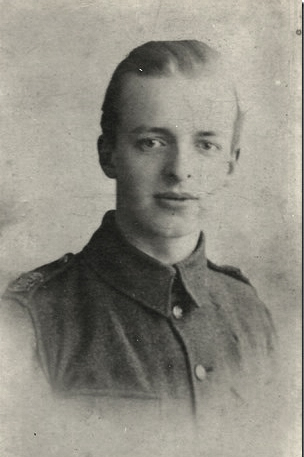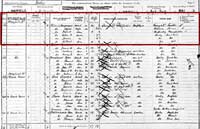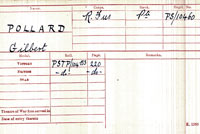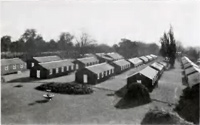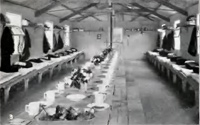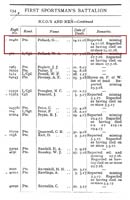Because Gilbert's Service Record doesn't appear to have survived, we have to try and piece together his story from other sources.
The first recruits to the 23rd Battalion arrived in Boulogne in November 1915 and were straight into fighting in the Somme area, suffering heavy casualties. It's likely that Gilbert was amongst slightly later volunteers who would be sent to France in 1916 to bring the Battalion numbers up to viable levels. The Battalion, was on the Western Front, thoughout the war, with the 99th Brigade in the 2nd Division.
Page 144 ROYAL FUSILIERS IN THE GREAT WAR
... only advanced about 300 yards; but the position could not be maintained, and their casualties were 14 officers and 240 other ranks. Insufficient preparation and support, reduced strength and the terrible state of the ground, had proved too heavy a handicap for units who had each performed excellent service before. Major Coxhead (9th Battalion) noted the state of the roads was so bad that the transport took three hours and a quarter to traverse the five miles to Becordel.
The 20th Battalion had a tour in the trenches north of Morval in the last week of October, and suffered 75 casualties, including five officers. They then moved into trenches to the north of Les Boeufs, and on November 6th, after three attempts, established a bombing post about midway between that village and Le Transloy. In this small action they had about 100 casualties. So the month wore on to the 13th, when the Battle of the Ancre was fought.
The Battle of the Ancre.--In this action, which in duration was only comparable to one of the many battles embraced under the general title of the Battle of the Somme, eight battalions of the Royal Fusiliers were involved, though one of them, the 4th, was in brigade reserve, and remained in the same position in Sackville Street, opposite Serre, all day, as the assaulting brigades did not reach their objective. The front of attack had a bad history, for it was here that several divisions attacked in vain, and suffered heavy loss, on July 1st. The situation on November 13th was very different. The gains south of the Ancre had placed the troops in a position to take the German positions north of the river in enfilade. On the other hand, the enemy's defences in this area were already formidable when they resisted our assault on ]uly Ist, and the succeeding period of four months had been spent in improving and adding to them in the light of the experience he had gained in the course of our attacks further south; ... the villages of Beaucourt-sur-Ancre and Beaumont Hamel, like the rest
~~~~~~~~~~~~~~~~~~~~~~~~~~~~~~~~~~~~~~
BATTLE OF THE ANCRE, NOVEMBER 13th Page 145
of the villages forming part of the enemy's original front in this district, were evidently intended by him to form a permanent line of fortification ... Realising that his position in them had become a dangerous one, the enemy had multiplied the number of his guns covering this part of the line ...*
The Germans, indeed, were confident that they had neutralised the disadvantages of the approach from the south by their new precautions, and General Ludendorff described the victory of the Ancre as "a particularly heavy blow, for we considered such an event no longer possible." ** But it is obvious that the tip of the salient, created by the Somme advance, was highly vulnerable, and it was there that the greatest successes were won. The preliminary bombardment had lasted two whole days, with bursts of great intensity, and at 5.45 a.m. on November 13th it developed into a very effective barrage.
On the northern flank of the attack, as we have seen, the 4th Battalion remained undisturbed the whole day, so little had the attack succeeded on that sector. The wire was insufficiently cut and the ground too sodden. Four other Fusilier battalions belonged to the 2nd Division, which lay north of Beaumont Hamel, between the 3rd and 51st Divisions. The 24th Battalion alone took part in the initial advance. As the left battalion of the 5th Brigade their flank was influenced by the failure further north. At 5.15 a.m. the attacking companies left the trenches in a dense fog, reformed in No Man's Land, and moved forward with the general advance at 5.45 a.m. The barrage was followed closely, the men being within 20 yards of it over the whole battalion front. Some shells, indeed, fell short and caused casualties, but the men followed cooly at a walking pace into the German front line trenches, and a numerous dug-out population emerged to surrender. The troops went on, and at 6:15 had takn the major part of their objective, the Green
* Despatch
** 'My War Memories' Vol. 1, p. 290
~~~~~~~~~~~~~~~~~~~~~~~~~~~~~~~~~~~~~~~~~~~~~~~~~
Page 146 ROYAL FUSILIERS IN THE GREAT WAR
line - the German third line system. C and D Companies were cleaning up the trenches. It was early realised that the assault on the left flank had been unsuccessful, and all trenches leading north were blocked. This advance, though not spectacular, was useful in the general scheme of things; and it had not been achieved without considerable losses. On the 14th the battalion's positions were taken over by the supporting battalion, the 2nd Oxford and Bucks.
On the left of the 24th the 2nd Highland Infantry had advanced, and the 127th Royal Fusiliers, as the supporting battalion, had passed through, and with the 2nd Oxford and Bucks had attempted to advance from the German third line to Munich Trench and Frankfort Trench. At 10 a.m. the third German line was strongly held, and four companies of the I7th Battalion, now reduced to a total strength of 180, were well to the east. They had met with a heavy enfilade fire owing to the units on the left of the 5th Brigade being held up. Some parties of the Fusiliers with the Oxfords and Bucks had penetrated into Munich Trench, but could not maintain themselves. After 10:30 a.m. the front line was reorganised with the battalion holding Crater Lane Trench, a line that was apparently further east than any other north of the Ancre held by our troops.* Later in the day the line of Wagon Road was also held. At 4:30 p.m. the Germans counter-attacked the advanced positions and attempted to work across the battalion's front towards Beaumont-Hamel, lying to the south-west. Artillery support was called for and the attack was not pressed. The 17th lost 187 in their advance, including Lieutenant E. P. Hallowes, Second Lieutenants K. W. Hamilton, G. C. Levon, C. W. Taylor, R. Davison, R. Pearce and H. J. Riches wounded. Munich Trench, reached but not held by the battalion, was attacked by other troops** on the 14th and by another division on the 15th, but without success.
* There was, of course, a small party outside Beaucourt, still farthereast.
** The 1st Royal Rifles and the 1st Berks, with the 23rd Royal Fusiliers in support.
~~~~~~~~~~~~~~~~~~~~~~~~~~~~~~~~~~~~~~
BATTLE OF THE ANCRE, NOVEMBER 13th Page 147
The 22nd and 23rd Battalions, belonging to the 99th Brigade, who were in reserve, found themselves committed to the support of the unsuccessful left flank of the Ancre attack. The 22nd went up to form a defensive flank to the 5th Brigade, but such were the difficulties that this object was not achieved until 9 a.m. on November 14th. But when the line was once taken up it was firmly held, despite a persistent and very accurate shell fire throughout the day. It was nervous and wasting work, but the battalion bore it so well that, on the 15th, they were able to leap forward and seize the Quadrilateral. They were reinforced by the 4th Battalion, who crossed the open and shell-swept ground with only 8 casualties. The position was consolidated and held till 7 a.m. on the 16th, when the battalion was relieved.
At 10 a.m. on the morning of the I3th A and C Companies of the 23rd Battalion had been placed under the orders of the G.O.C. 5th Brigade, and about 5 p.m. they were sent to support the 2nd Highland Light Infantry in the third German line. They were then in the rear of the 17th Battalion and on the right of the 24th. B and D Companies had been lent to the 6th Brigade, and at 7 p.m. they succeeded in carrying the front forward to the second German line. The whole battalion supported the unsuccessful attack on Munich Trench by the 1st Royal Rifles and 1st Berks. on the 14th. The 2nd Division's advance, considerable on the right and gradually lessening on the left, owed not a little to these four Fusilier battalions.
Another Fusilier battalion which took part in the battle of the Ancre on November 13th was the 7th. This unit
formed part of the 190th Brigade of the 63rd (Naval) Division, which was engaged immediately north of the river. At 5.45 a.m. C and D Companies advanced with the H.A.C. on their right. On their left was the redoubt which, for the whole of the day, made a deep salient in the British position. Both of the leading companies met with heavy rifle and machine gun fire. The first two waves of C were held up by the remains of the German wire, and
~~~~~~~~~~~~~~~~~~~~~~~~~~~~~~~~~~~~~~~~~~~~~~
Page 148 ROYAL FUSILIERS IN THE GREAT WAR
after losing heavily returned to the starting point. There, in our front line, were the second two waves and about 60 men from other battalions. It was so foggy that no-one could see what was actually happening, and Captains Foster and Clarke decided to make another advance with all the men in the trench. The men came again under heavy fire, and all the platoon commanders - Second Lieutenant W. Ford, Second Lieutenant St. Aubyn, Second Lieutenant Bouchier and Sergeant Cookson - became casualties. Nevertheless, the German front line was rushed in five minutes. In it were found 20 German dead, and one officer and 50 men surrendered. A machine gun was also captured. The trench line was consolidated and blocked against the German strong point, and the company remained there until ordered to proceed to the Green line. Sergeant Bright with three Lewis guns and 13 men was left to hold up the German strong point. The Green line was reached with little loss except from snipers and was held till about 9 p.m., when, on relief by the H.A.C., they went back to the German front line. D Company, in the meantime, had made three attempts to advance, the last with the elements of several other battalions, and had failed to make headway against the German rifle and machine gun fire. At the end of the third attack the company was reduced to 50, and Captain Rattigan decided to hold on where he was in front of the German wire. They remained in this position for four and a half hours- During this time Captain Rattigan was killed, and Second Lieutenant Downing, finding a mine shaft leading back, went down it, reported to battalion headquarters and was
ordered to bring the remains of the company back to the British front line.
Sergeant Bright held up the German strong point all day. He was not a little assisted by the supply of German bombs found in the trench, and by Private Hawkesley, who daringly lay out along the parapet with a Lewis gun. Captain Goddard, of B Company, took over this post at 3 p.m., and the captured trench was organised. The
~~~~~~~~~~~~~~~~~~~~~~~~~~~~~~~~~~~~~~~~~~
BATTLE OF THE ANCRE, NOVEMBER I4th Page 149
battalion was reorganised about 2 a.m. on November 14th, and at 6 a.m. the Fusiliers attacked once more. It was at this point that the 7th Battalion came into contact with the I3th Battalion Royal Fusiliers, who attacked between the 13th Rifle Brigade and the 13th King's Royal Rifle Corps. The 13th moved off a little too eagerly and suffered some casualties from our own barrage. They withdrew 50 yards and then resumed the advance under a harassing machine gun fire from Beaucourt village. A strong point on the left flank resisted with great deter+mination, and the I3th Rifle Brigade were to the rear of the 13th Royal Fusiliers when the first objective was taken. Meanwhile, Captain Goddard, with the 7th, had amalgamated the battalion's two waves, and after one and a half hours' shelling of the final objective, advanced and took it without much opposition. He had turned to the right and with elements of the 13th Battalion, the 13th K.R.R.C., and the H.A.C., consolidated the right flank on the bank of the Ancre, south-east of Beaucourt, which had fallen a little earlier to the charge of Freyberg's force.
Up to this point the position on the left of the 13th Battalion still caused trouble. Most of the casualties suffered by the 7th in their advance to the final objective had come from this quarter, and the 13th remained on the first line captured. But the I0th Battalion, who, like the 13th, belonged to the 111th Brigade, had had the pleasant experience of co-operating with a tank in the reduction of the German redoubt which had held up the centre of the 63rd Division. The mere appearance of the tank seems to have been sufficient, and without firing a shot the I0th Battalion took 270 German prisoners,* and three machine guns. They also liberated 60 British prisoners who had been well treated, but were naturally glad to get back to their own army. The 7th Battalion passed from this area and the 13th did not figure again in the battle. The former had attacked 22 officers and
* Eight hundred prisoners in all were taken from this redoubt.
~~~~~~~~~~~~~~~~~~~~~~~~~~~~~~~~~~~~~~~
Page 150 ROYAL FUSILIERS IN THE GREAT WAR
629 other ranks strong. They lost I3 officers and 331 other ranks, more than half the total strength. The casualties of the 13th were 8 officers (including Lieut.-Colonel Ardagh, wounded) and 130 other ranks. But the victory was complete. It was a great blow to German prestige, and it made an important improvement in the British positions.
*********************************************************
There were still some local operations in this area before the battle died down and a final line could be organised for winter. The I0th Battalion took a prominent part in these attempts to round off the gains of the first three days. Part of the final line still remained in German hands. The 13th Battalion, on the morning of the 14th, had been held up by opposition on its left, and patrols sent out failed even to locate the objective. Muck Trench, as it was called, continued to lure the 111th Brigade, and the I0th Battalion attacked at dawn on November 16th with the object of capturing it. They were beaten back by intense machine gun fire. In the afternoon two bombing parties attempted to get forward and actually reached the trench, but they were promp Stephenson was killed on this occasion. The German barrage prevented a third attempt, but Second Lieutenant Ground succeeded in establishing two posts in the trench on the left before dusk, and two others were established during the night by Second Lieutenant Bainbridge. These posts were reinforced and organised. But during the night of the 17th the machine gun team in the trench was shelled and almost wiped out. At 6.10 a.m. on the 18th the battalion attacked on the right of the 32nd Division and stormed all its objectives but one. Unfortunately these gains had to be abandoned owing to the failure of the right of the 32nd Division. On November 19th the 10th delivered yet another attack. Two patrols, under Second Lieutenants Bainbridge and Heywood, respectively, reached the objective, but were compelled ...
Transcribed from
'The Royal Fusiliers in the Great War' by Herbert Charles O'Neill, Published 1922

